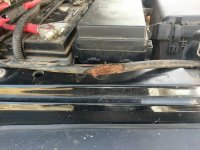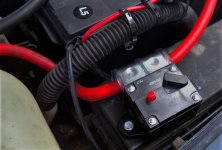You are using an out of date browser. It may not display this or other websites correctly.
You should upgrade or use an alternative browser.
You should upgrade or use an alternative browser.
Winch power cable - splice or replace?
- Thread starter TANK
- Start date
Kalums
New member
Personally those cables are not that expensive (unless something has changed drastically since I had my 08) ide just replace the whole cable because if you splice it you will always have problems with connectivity and corrosion. Just do it right the first time and save yourself time and headaches later.Long story short, I didn't pay attention to how my winch negative power cable was routed and it managed over time to wiggle free with its extra length and rub against a pulley on the engine.
Is this something I can just splice or would you recommend just replacing the entire cable? Thanks.
View attachment 247579
Sent from my LG-LS997 using WAYALIFE mobile app
DWiggles
Caught the Bug
Personally those cables are not that expensive (unless something has changed drastically since I had my 08) ide just replace the whole cable because if you splice it you will always have problems with connectivity and corrosion. Just do it right the first time and save yourself time and headaches later.
Sent from my LG-LS997 using WAYALIFE mobile app
THIS :yup:
And learn the lesson!! had this been the positive lead things would have gone south quickly... and you KNOW you'r scared of the south... we all are :cheesy:
TANK
New member
Believe me, I know. Scared the hell out of me when I saw it. I figured there would be possible issues with splicing. I'll get a new cable for sure now.THIS :yup:
And learn the lesson!! had this been the positive lead things would have gone south quickly... and you KNOW you'r scared of the south... we all are :cheesy:
And yes, before anyone asks, the winch is disconnected currently. No way I'd let that sit.
jesse3638
Hooked
Don't mean to Hijack but I had a quick question. It's there a large fuse one can install as close to the terminal? So had this been the positive cable it would have blown it instead of potentially causing a fire.
Sent from my 831C using WAYALIFE mobile app
Sent from my 831C using WAYALIFE mobile app
piginajeep
The Original Smartass
Don't mean to Hijack but I had a quick question. It's there a large fuse one can install as close to the terminal? So had this been the positive cable it would have blown it instead of potentially causing a fire.
Sent from my 831C using WAYALIFE mobile app
Yes, we install them on our police car builds. Painless wiring sells them
Sent from my iPhone using WAYALIFE mobile app
Yes, we install them on our police car builds. Painless wiring sells them
You mean to tell me that a fuse is better than a wired remote disconnect? :crazyeyes:
piginajeep
The Original Smartass
You mean to tell me that a fuse is better than a wired remote disconnect? :crazyeyes:
We have fuses for fuses [emoji23]
When's there's 5k plus in electronics and lives depend on it.. yup !
Jesse you can pick up the fuse cheap on amazon.
Sent from my iPhone using WAYALIFE mobile app
jesse3638
Hooked
Thanks for the help everyone. One of these days I'll own a winch and now I know how to wire it up.
Sent from my 831C using WAYALIFE mobile app
Sent from my 831C using WAYALIFE mobile app
We have fuses for fuses [emoji23]
When's there's 5k plus in electronics and lives depend on it.. yup !
Jesse you can pick up the fuse cheap on amazon.
A few thoughts:
- Really glad for the OP this wasn't the feed line (like other's comments). Also glad he found it prior to using winch in this condition.
- A fuse or CB (like WJCO's) makes a lot of sense for systems that are being used regularly (like police or FF applications)
- Personally, not a fan of remote actuated switch / relays at these current levels for the application in question (I.e. winches) ...I much prefer manual switches with margin
- For an 8k winch, a 300A fuse or CB would be adequate as max draw is just under that (carry spares!)
- Above 8k require a heavier protection circuit. For instance, 12k lb winch pulls 440+ amps. Which brings me to a hypothetical...
Scenario: Assume, instead of "return", OP's "feed" line was chewed through. BUT, he had a 300A fuse (or CB) protection in place. So the new circuit created by the weld of the cable to whatever it was touching would be allowed to feed up to 300A without tripping the CB (or blowing the fuse). Depending upon the quality of the new (unintended) connection, that current could continue for several hundredths of a second before the new connection either (a) melted through or (b) welded further, enabling more current and therefore tripping the protection in place.
Alternately, the cable could hop around, sparking every time it touched ground. This is unlikely, as the current in question would be fairly likely to create a temp weld when it touched something allowing an adequate "return" path.
The consideration for ya'll is: What would several hundredths of a second at just under 300A be capable of in the engine compartment? In my personal experience, the new connection "returned" via the brake line, which in turn vaporized the brake fluid inside, which is what started the fire. (Auto accident root cause, btw.) Power steering fluid would work, too. Not to mention the fuel rails. I don't remember if the vehicle in question had circuit protection or not.
Just a thought...
Cheers
jesse3638
Hooked
A few thoughts:
- Really glad for the OP this wasn't the feed line (like other's comments). Also glad he found it prior to using winch in this condition.
- A fuse or CB (like WJCO's) makes a lot of sense for systems that are being used regularly (like police or FF applications)
- Personally, not a fan of remote actuated switch / relays at these current levels for the application in question (I.e. winches) ...I much prefer manual switches with margin
- For an 8k winch, a 300A fuse or CB would be adequate as max draw is just under that (carry spares!)
- Above 8k require a heavier protection circuit. For instance, 12k lb winch pulls 440+ amps. Which brings me to a hypothetical...
Scenario: Assume, instead of "return", OP's "feed" line was chewed through. BUT, he had a 300A fuse (or CB) protection in place. So the new circuit created by the weld of the cable to whatever it was touching would be allowed to feed up to 300A without tripping the CB (or blowing the fuse). Depending upon the quality of the new (unintended) connection, that current could continue for several hundredths of a second before the new connection either (a) melted through or (b) welded further, enabling more current and therefore tripping the protection in place.
Alternately, the cable could hop around, sparking every time it touched ground. This is unlikely, as the current in question would be fairly likely to create a temp weld when it touched something allowing an adequate "return" path.
The consideration for ya'll is: What would several hundredths of a second at just under 300A be capable of in the engine compartment? In my personal experience, the new connection "returned" via the brake line, which in turn vaporized the brake fluid inside, which is what started the fire. (Auto accident root cause, btw.) Power steering fluid would work, too. Not to mention the fuel rails. I don't remember if the vehicle in question had circuit protection or not.
Just a thought...
Cheers
This was my main concern and my reason for a fuse or circuit breaker. I suppose anything can still happen no matter the amount of safety precautions.


